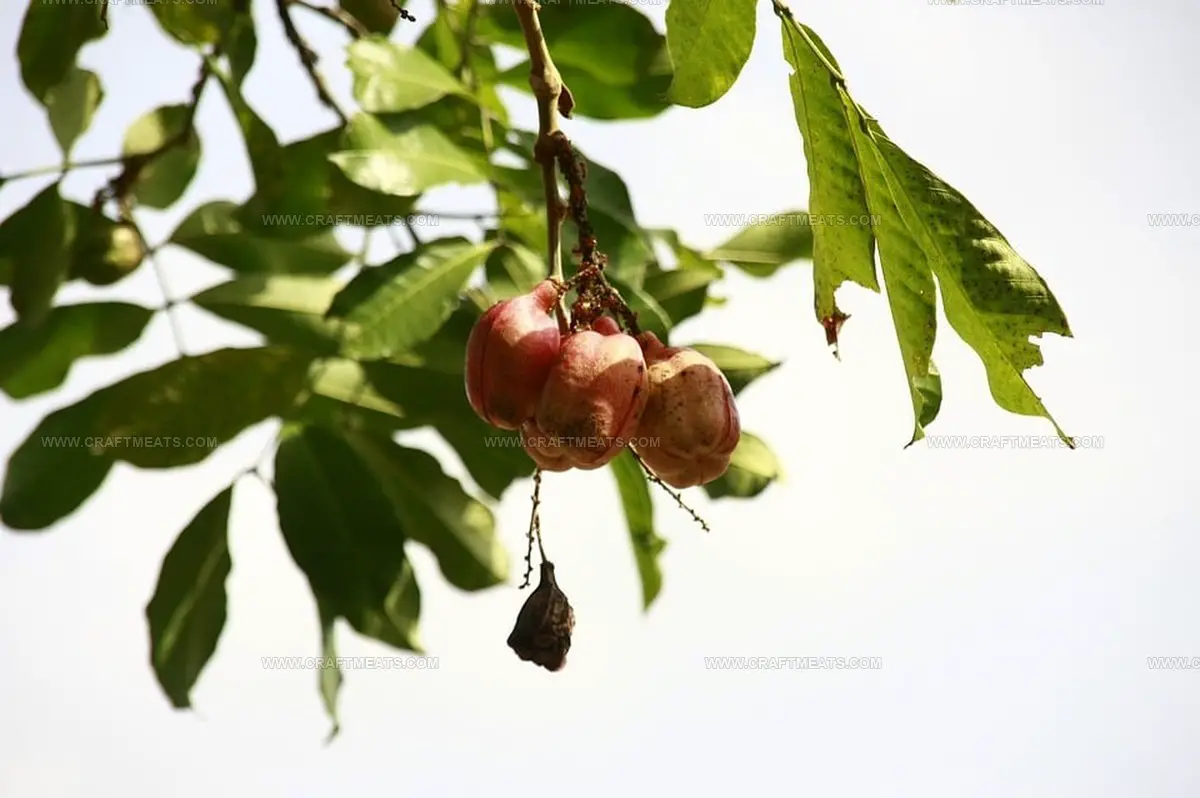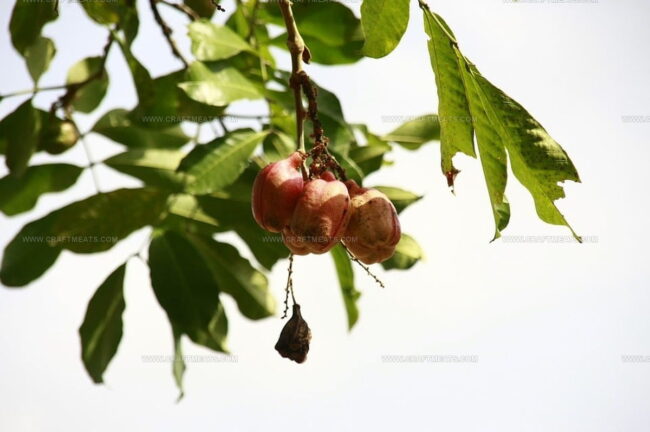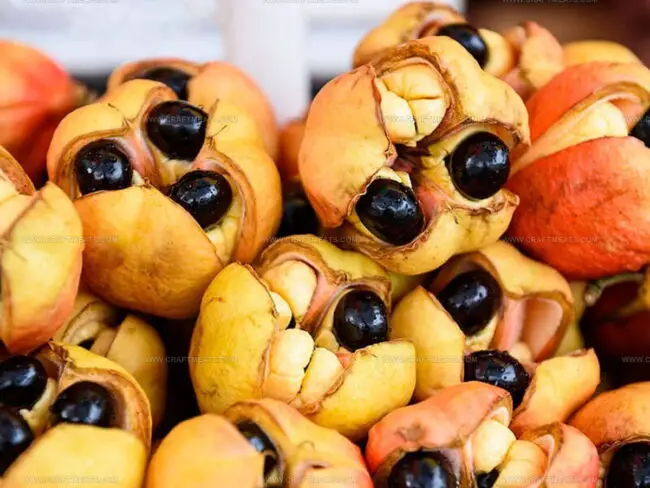What Does Ackee Taste Like? Find Out This Unique Fruit’s Flavor
Ackee, a peculiar tropical fruit native to Jamaica, sparks curiosity among food enthusiasts worldwide.
Exotic and mysterious, this unique ingredient carries cultural significance beyond mere culinary interest.
Jamaican cuisine celebrates ackee as a beloved staple that transforms ordinary meals into extraordinary experiences.
Adventurous eaters often wonder about its flavor profile and culinary potential.
Many people remain uncertain about how this unusual fruit might tantalize their taste buds.
Unfamiliar textures and unexpected characteristics make ackee an intriguing gastronomic mystery waiting to be unraveled.
Dive into this article to unlock the sensory secrets of this remarkable Caribbean delicacy.
What Is Ackee Fruit?
Ackee is a unique fruit that comes from the same plant family as lychee, but it has a taste and look all its own.
Its flavor is gentle, with a smooth, slightly nutty note, some say it’s a little like garden peas with just a touch of sweetness.
The outside of the fruit is spiky and starts out looking like a small, odd pear, turning rosy as it ripens.
Once fully ripe, ackee splits open on its own, locals call this “smiling” or “yawning”, showing off its creamy yellow flesh and glossy black seeds inside.
Only the light-colored flesh is safe to eat; the seeds and any unripe parts are poisonous and can be very dangerous if not handled the right way.
Ackee originally grew in West Africa, but it’s now found in warm spots around the world, Jamaica is especially known for it and even calls it their national fruit.
Even though ackee looks a little like lychee and seems like it might be sweet, the taste is closer to a mild vegetable than a fruit.
It’s important to prepare ackee carefully, since eating unripe or poorly cooked ackee can cause serious illness, sometimes called Jamaican vomiting sickness.
When picked and cooked safely, ackee is enjoyed in many Caribbean dishes and brings a gentle, buttery flavor that’s easy to love.
Taste of Ackee
Ackee is a bright yellow fruit that turns soft and creamy when cooked, often reminding people of scrambled eggs or cream cheese.
Its flavor is mild and gentle, with a subtle nuttiness and a slight hint of bitterness.
Many compare the taste to almonds, chickpeas, or avocados, but ackee isn’t sweet like most fruits.
The texture is smooth and buttery, melting in your mouth and adding a comforting touch to Caribbean dishes.
If you’re working with fresh ackee, it’s important to handle it carefully.
Always remove the large, shiny black seeds from the yellow flesh, discard any pink or red skin and the outer shell, and rinse the yellow sections well before cooking.
In the United States, only canned ackee is sold, as it’s already safe to eat.
Ackee is a great choice if you enjoy mild, creamy foods and want to try something unique.
It brings a soft, nutty flavor and a rich texture to recipes, making every bite a little different from the usual tropical fruits.
Butter Ackee vs. Cheese Ackee
Butter ackee and cheese ackee are two types of ackee fruit found in Jamaica, and they each have their own texture and taste.
Both are used in Caribbean cooking, but people often have a favorite depending on the dish:
Butter Ackee
Ways To Use It In Cooking
Cheese aknee is a wonderfully versatile cheese that can be enjoyed in both simple and creative dishes. Its rich flavor and smooth texture make it a fantastic ingredient to keep in your kitchen:
Cheese Ackee
Ackee in Popular Dishes
Ackee is a key ingredient in many well-loved Caribbean dishes, especially in Jamaica.
Its soft, creamy texture and mild flavor make it a great match for both savory and spicy foods.
Ackee and Saltfish
This is Jamaica’s national dish.
Ackee is cooked with salted cod, onions, tomatoes, sweet peppers, and spices.
The dish looks a bit like scrambled eggs but tastes mild, savory, and satisfying.
It’s often served with fried dumplings, boiled green bananas, or roasted breadfruit.
Ackee Patties
Flaky pastry pockets filled with seasoned ackee.
Eaten as a snack or light lunch.
Ackee and Callaloo
Ackee cooked with leafy green callaloo, onions, and spices.
A favorite vegetarian dish in many homes.
Ackee Stew
Ackee added to rich vegetable or seafood stews.
Gives the stew a creamy, smooth taste.
Ackee Rice
Steamed rice mixed with ackee and vegetables.
A simple but comforting side dish.
Is It Safe to Eat Raw Ackee?
Ripe ackee offers safe eating when its pod naturally splits open.
Black seeds become visible once the fruit reaches proper maturity.
People can enjoy these white or yellow arils directly without cooking when fully prepared.
Quick Facts To Know
Jamaica's ackee sales jumped from US$4.4 million in 2000 to US$20 million in 2016.
Jamaicans call this fruit by several names: ackee, achee, ackee apple, or Blighia sapida.
Ackee belongs to the soapberry family, sharing roots with rambutan, lychee, and longan.
Beyond its tasty fruit, workers use ackee trees to make soap, hardwood for construction, perfumes, and medicine.
How to Eat Ackee Fruit
Ackee shares similarities with tomatoes as a fruit often used in savory cooking. People in West African countries like Cameroon, Ghana, and Senegal enjoy ackee in different ways - raw, fried in oil, or mixed into soups.
Jamaicans frequently cook ackee with codfish, onions, and tomatoes, while others prefer it curried and served with rice.
Seeds from unripe ackee can cause serious health problems, so people only eat its soft, creamy inner part.
Shoppers in the United States can only find canned, pre-prepared ackee because of seed toxicity. Newcomers to this fruit should steer clear of preparing raw ackee without expert knowledge!
Ackee starts with a soft cream color when first opened from the can. During cooking, it changes to a bright yellow shade that looks just like scrambled eggs.
Does Ackee Have a Cheese Flavor?
Ackee fruit boasts a mild yellow flesh with a unique taste profile.
People often compare its flavor to cream cheese, with subtle hints of nuttiness and a slight bitter edge.
Comparisons sometimes include garbanzo beans, avocados, and almonds.
Its texture feels similar to jackfruit, offering a juicy and smooth sensation when eaten.
What Happens When You Eat Ackee?
Key health perks from ackee fruit might include lowering blood pressure, boosting energy, helping body healing and growth, supporting digestion, cutting cholesterol, building strong bones, strengthening immune response, and improving blood flow.
Is Ackee and Saltfish a Healthy Meal?
Caribbean chefs love making ackee and saltfish with side dishes of grilled plantain and green vegetables.
Smart cooks can modify favorite meals to boost nutrition.
Rich in healthy ingredients, ackee provides nutrients like fatty acids that may help protect heart health.
How Long Does Ackee Take to Cook?
Boiling ackee takes careful timing.
Salt and water go into a big pot before adding the fruit.
You want the ackee to reach just the right softness without turning into mush.
Watch it closely while cooking and check its texture after about ten to fifteen minutes.
Gentle boiling helps keep the ackee from breaking down too much.
Stop cooking when the fruit feels tender but still holds its shape well.




Liam O’Sullivan
Founder & Culinary Content Creator
Expertise
Recipe Development, Traditional Irish and European Cuisines, Food Styling and Photography, Culinary Education
Education
Dublin Institute of Technology (DIT) – School of Culinary Arts and Food Technology
Ballymaloe Cookery School
Isabella brings a global spark to the Craft Meats table. Born in Florence and trained at the Apicius International School of Hospitality, she blends classic Italian flavor with modern writing that’s easy to follow and hard to forget.
Her additional training at the Italian Chef Academy fueled her love for well-crafted dishes, especially ones that spotlight beautiful cuts of meat.
She’s a food writer with heart, and a deep love for storytelling through single recipes. Her goal? To help you cook with more confidence and a little more joy, no matter where you start.